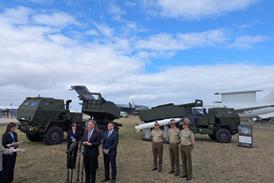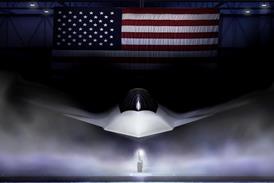A generation ago, if you had been asked to name the Latin American country most likely to become a global powerhouse of aerospace manufacturing, you may well have plumped for Argentina over Brazil or Mexico. But while Brazil's Embraer has become one of the world’s leading airframers and Mexico is fast establishing itself as a key offshoring manufacturing hub for Bombardier and others, Argentina’s industry has been in decline since the 1980s, attracting little outside investment and producing little in the way of original programmes.
Any ambitions to return to Argentina’s glory days as a major regional player in aircraft manufacturing have been cast into doubt by the country’s new government, led by president Mauricio Macri. An economic liberal, elected in December, he looks likely to reverse many of the initiatives from the 12-year rule of his predecessors, the left-leaning Nestor and Cristina Kirchner. These included plans to revive state-owned aerospace champion Fábrica Argentina de Aviones (FAdeA) with an injection of resources and new contracts – some of which have begun to have an impact.
Set up in the 1920s in the land-locked city of Cordoba as the Fábrica Militar de Aviones (FMA) the company became Lockheed Martin Aircraft Argentina (LMAASA) after privatisation in 1995 by then-president Carlos Menem. FAdeA was bought back in 2010 by the Cristina Kirchner government with the argument Lockheed Martin had reduced it to a pedestrian aircraft maintenance operation. In the decades after the Second World War, helped by a “brain gain” from Europe, the company established a reputation as one of the most innovative manufacturers in the southern hemisphere.
In 1947, it became the first firm in that hemisphere to design and fly a fighter prototype, in the form of the I Ae 27 Pulqui I.Three years later the swept-wing Pulqui II flew and, in 1953, the Pulqui III took to the air. Although none of these groundbreaking designs was ever put into production – a destiny shared by most of the 30-odd aircraft designs created in Cordoba – more than 1,500 aircraft were manufactured in the city, mostly foreign models built under licence. Local designs to make it to the production line included the Pucará attack aircraft and the Pampa jet trainer.
During the Kirchners' tenure from 2003 (Cristina succeeded her husband in 2007) a series of optimistic plans were announced to return new aircraft production to Cordoba. The main initiative was for the manufacture of 40 IA 63 Pampa III trainers and the assembly under licence of Chinese Changhe Z-11 helicopters (a reverse-engineered Airbus Helicopters AS350 clone) kits, but no significant government orders or funds followed. A 2013 plan to locally manufacture Pakistani-Chinese CAC/PAC JF-17 light supersonic fighters to replace the air force’s obsolete Dassault Mirage and McDonnell Douglas Skyhawk fighters, was to be another unfulfilled promise.
A flagship project for co-operative production of the IA-73 primary/basic trainer with other South American countries had appeared one of the most promising mooted schemes. Conceived as a replacement for the venerable Beechcraft T-34 Mentor, that reached the end of its operational life with the Escuela de Aviación Militar (EAM) pilot school in October 2011, Argentina’s industry is leading the programme with suppliers from partner nations. But a lack of commitment from some of the larger regional air forces has meant the aircraft’s potential market has shrunk considerably.
A 2011 programme for re-engining 20 of the remaining Pucará twin turboprop counter-insurgency aircraft of the Argentine Air Force into the IA-58H standard – with new Pratt & Whitney Canada PT6A-62 engines and modern electronic cockpit displays – is moving at a glacial pace. Israel Aerospace Industries is FAdeA’s technical partner in the upgrade programme, and first flight of the prototype took place on 24 November 2015.
Aside from the IA-73, the most significant international co-operation has been for Argentinian participation in the Embraer KC-390 tactical transport announced at the 2011 LAAD defence show in Brazil. FAdeA was contracted to build spoilers, doors for the nose landing gear, ramp door, flap fairings and tail cone. The fact this programme is the first to actually bring hard cash into the company in many years is perhaps why it has managed to move forward when all others have stumbled due to lack of local funding and orders.
In August 2014, the first rear upper cargo hold door structure was delivered to Embraer’s Gavião Peixoto plant with the second set following in July 2015. “We have invested $35 million for the refurbishment of FAdeA installations and the acquisition of advanced technology [and] 76 thousand hours in employee training," said former Argentinian secretary of science technology and defence production, Santiago Rodriguez, at the KC-390 roll out in October 2014.
With little aircraft production in Cordoba, the company has had to rely on maintenance to make ends meet. Argentinian Air Force IA-58 Pucarás, IA-63 Pampas, Embraer T-27 Tucanos, Lockheed Martin C-130H Hercules' and Fokker F28s and F27s have undergone overhaul at the site. Argentine Naval Aviation (COAN) Lockheed Martin P-3B Orion maritime patrol aircraft are also set to join that list. Additionally, Argentine commercial aircraft have been maintained and painted there.
Macri has appointed Cristina Salzwedel as president of FAdeA and she will have to guide the company’s 1,700 employees into a challenging new political and economic environment. The nation's new defence minister, Julio Martinez, made his first visit to FAdeA on 1 February, where he declared: “We have a factory that has to return to be what it was in the past, the pride of Cordoba and of Argentina," before noting: "There are many ongoing projects that show little progress and there are others that move forward, but with only with great effort." According to the minister, pre-existing issues were magnified by the previous government’s foreign exchange limitations and a lack of funding shrinking the supplier base and damaging the relationship with clients.
The IA-73 is perhaps typical of FAdeA projects that have struggled to gain traction. It began with excellent prospects with the Union of South American Nations' [UNASUR] defence council approving the project in 2012 as a regional co-operation programme between South American nations under the UNASUR umbrella. However from the start problems were evident, with Brazil declaring it would participate with technology and funding but would not purchase the new aircraft, although it remains the supplier of the project funding through the Brazilian state development bank BNDES. At the first meeting there were representatives from nine countries but by 2014 the expected order list had shrunk to three, with 50 units for Argentina, 24 for Venezuela and 18 for Ecuador.
The workshare is expected to be 62% for Brazil, 28% for Argentina and 5% each for the other two countries but, according to the Brazilian Ministry of Defence, “these share numbers may still change while the financing conditions are being discussed”. Brazilian companies will be responsible for the wing and canopy, landing gears and cockpit panel avionics integration, air conditioning, oxygen and pressurisation systems. Argentinian industry will build the composite fuselage and do final assembly and integration. The industrial activities of the Venezuelan and Ecuadorian industries are still undefined. Propellers, the power plant and ejection seats will be imported.
According to Brazilian MoD representative to the programme, retired air force colonel Hilton Grossi Silveira, negotiations have halted due to Argentina’s and Venezuela’s recent sweeping, and still ongoing, political and economic changes. Once the four partners decide to restart it all, the legal and administrative steps required are already set and approved by the partner governments, he says.
Besides FAdeA, the remaining industrial partners in this programme are Argentina’s cockpit system integration expert Redimec, plus Akaer, Flight Technologies, Avionics and Novaer from Brazil, and two state-owned defence companies: Ecuador’s DIAF and CAVIM, from Venezuela. To best combine the skills and means of the participant countries’ industries it was decided in 2014 to create a new consortium called UNASUR Aero to manage the programme, but this has taken longer than envisaged. Unit cost was expected to be around $4 million with the development cost of the new aircraft $40 to $60 million. The involvement of Venezuela and Ecuador adds doubts regarding the sourcing of US-owned engines. According to Col Grossi: “The company that will supply the engine has not been selected yet and as regards the ejection seat, we have seen no supply restrictions from any of the contacted companies, not even by British industry."
Requesting anonymity, Brazilian sources closely connected to this programme have said the preferred engine is the Pratt & Whitney Canada PT6A-25A turboprop (the -25C version is used in the Embraer Tucano). The -25A variant is a civilian rated product with no USA International Traffic in Arms Regulations export security restrictions. Requests for information regarding the possibility of exporting the PT6A-25A to countries participating in the programme has so far not been formally answered by P&WC. Brazilian sources have also identified the Ukranian Ivchenko-Progress AI-450S turboprop as the leading non-Western engine option in case the PT6 sale to Venezuela is not authorised.
Col Grossi says once the new UNASUR Aero company is set up, the investment share and the financial equation will be addressed. With the financing conditions decided, a formal funding request by the partners will be forwarded for evaluation by BNDES. The Brazilian sources add the delay of this last phase is mostly due to the fact programme financing by BNDES has so far not been possible due to the lack of financial guarantees from partner nation central banks. Only after all this is resolved will the development of two prototypes and two full-scale mock-ups begin.
Source: Flight International























